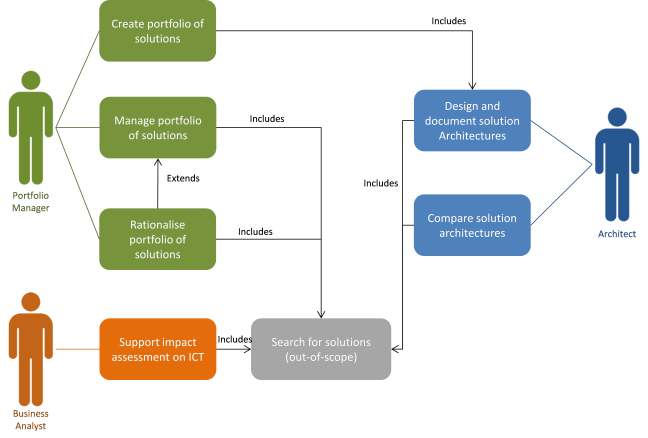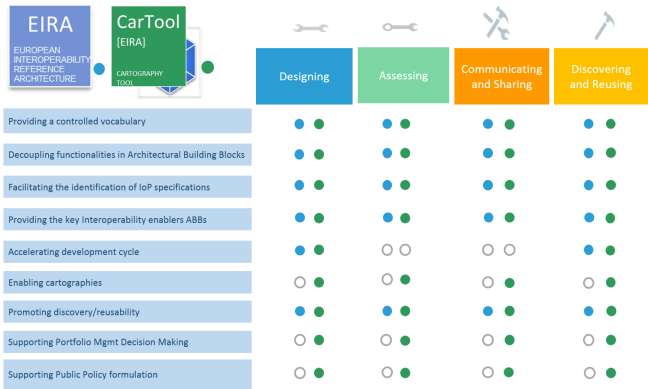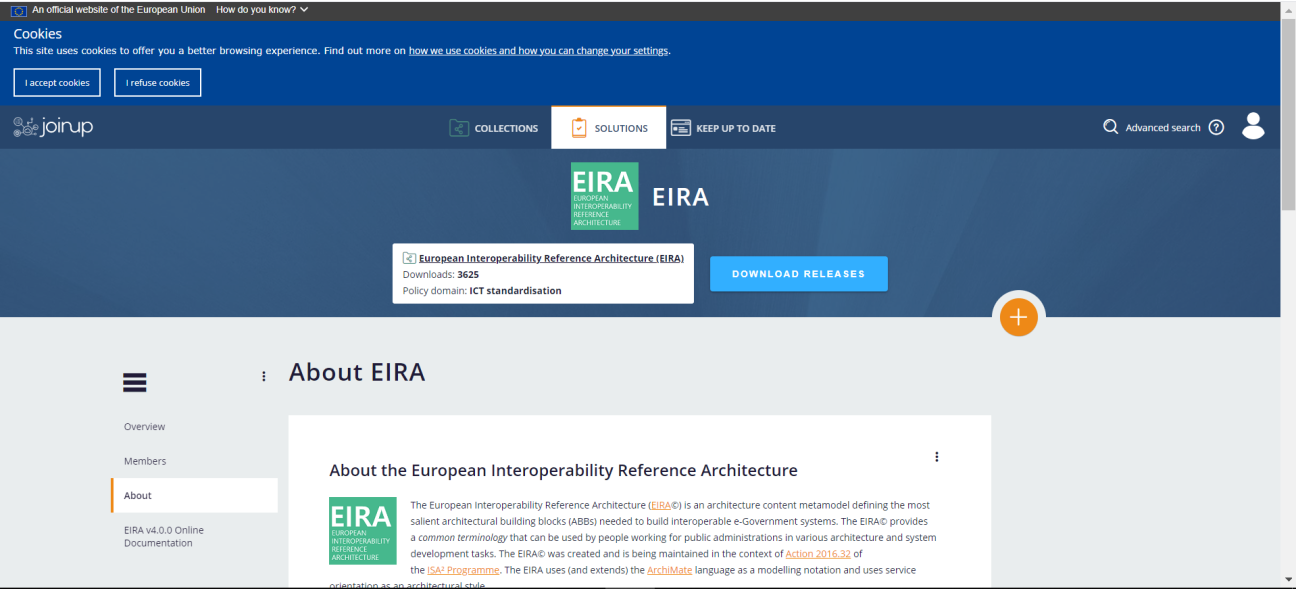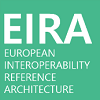This section gives an overview of the European Interoperability Reference Architecture (EIRA©).
Background
The Digital Single Market (DSM) strategy2 , meant to ensure the free movement of goods, persons, services and capital is built on three pillars: (1) improved access for consumers and businesses to digital goods and services across Europe; (2) creating the right conditions and a level playing field for digital networks and innovative services to flourish; (3) maximising the growth potential of the digital economy.
Interoperability is doubtlessly one of the means to achieve this, improving the cooperation between public administrations and removing barriers for administrations, businesses, and citizens. Given the rapidly growing amount of information exchanges, driven by the modernisation of public administrations, the need for interoperability in Europe is higher than ever. Solution developers in all domains of the public sector recognise interoperability and reusability as being essential to a solution design.
The European Interoperability Framework (EIF) defines interoperability as follows: “The ability of organisations to interact towards mutually beneficial goals, involving the sharing of information and knowledge between these organisations, through the business processes they support, by means of the exchange of data between their ICT systems”.
Attaining interoperability calls for coordination across borders and sectors when developing digital solutions. Key players in this process experience the following requirements:
- A common terminology to design, assess, and communicate about eGovernment solutions: Public administrations can benefit largely from common terminology to communicate efficiently and unambiguously – across language barriers and domain-specific jargon – when designing, assessing, documenting and discovering Solution Building Blocks (frameworks, tools, services) used to deliver interoperable digital public services;
- Stable and standardised interfaces for digital public services: IT architects and developers are tasked with defining stable interfaces between digital public services, according to open standards and interoperability specifications (through, for instance, the European Library of Interoperability Specifications, ELIS), so that partners can rely on them to build new, aggregated digital public services and avoid vendor lock-in;
- An overview of already existing Solution Building Blocks (SBBs): Decision makers, public procurers and architects in public administrations gain value from being able to find already existing (reusable) Solution Building Blocks that have been developed in-house or by others, to unlock the potential of shared development effort and to be able to find best-in-class reusable components and services.
Characteristics and Tools
The ISA² Programme in the past and, currently DEP Programme and provide concrete interoperability solutions that contribute to making the modernisation of public administrations a success story. It, among others, developed the European Interoperability Reference Architecture (EIRA©) to guide public administrations in their work to provide interoperable European public services to other public administrations, businesses, and citizens.
The EIRA© is a four-view reference architecture for delivering interoperable digital public services across borders and sectors. It defines the required capabilities for promoting interoperability as a set of Architecture Building Blocks (ABBs). The EIRA© has four main characteristics
- Common terminology to achieve coordination: It provides a common understanding of the most salient Architecture Building Blocks needed to build interoperable public services.
- Reference architecture for delivering digital public services: It offers a framework to categorise (re)usable Solution Building Blocks (SBBs) of an eGovernment solution. It allows portfolio managers to rationalise, manage and document their portfolio of solutions.
- Technology- and product-neutral and service-oriented architecture (SOA) style: The EIRA© adopts a service-oriented architecture style and promotes ArchiMate® as a modelling notation. In fact, the EIRA© ABBs can be seen as an extension of the model concepts in ArchiMate®.
- Alignment with EIF and TOGAF: The EIRA© is aligned with the European Interoperability Framework (EIF) (2) and complies with the context given in the European Interoperability Framework – Implementation Strategy (EIF-IS) (4). The views of the EIRA© correspond to the interoperability levels in the EIF: legal, organisational, semantic and technical interoperability which are already anchored in the National Interoperability Frameworks (NIFs) of the Member States. Within TOGAF® and the Enterprise Architecture Continuum, EIRA© focuses on the architecture continuum. It reuses terminology and paradigms from TOGAF® such as architecture patterns, building blocks and views. This not only assures a high level of quality but also allows architects to easily understand EIRA© and relate it to existing work.
To support both architects and portfolio managers in their use of the reference architecture, a set of tools is provided:
- an ArchiMate® file that can be used with common Architecture software;
- the "Cartography tool" in the form of an open-source plugin to the Archi® 4.9, 4.10 and 5 modelling tool, which allows documenting Solution Building Blocks according to the EIRA© (by means of stereotyping and adding attributes) and discovering reusable solutions from a documented cartography, such as the European Interoperability Cartography Solutions.
Target users and use cases
The EIRA© has the objective to respond to the above needs by supporting users in the following scenarios:
- Designing: accelerate the design of eGovernment solutions that support the delivery of interoperable digital public services (across borders and sectors);
- Assessing: provide a reference model for comparing existing architectures in different policy domains and thematic areas, to identify focal points for convergence and reuse;
- Communicating and sharing: help documenting the most salient interoperability elements of complex solutions and facilitate the sharing of (re)usable solutions.
- Discovering and reusing: ease the discovery and reuse of interoperability solutions.
More specifically, the reference architecture targets the following users within public administrations of Member States or EU institutions:
- Architects, Enterprise Architects as well as Solution Architects, that are responsible for the design of solution architectures;
- Business analysts responsible for assessing and to study the impact of changes in the (external) environment on IT systems;
- Portfolio managers responsible for maintaining the catalogue of assets related to the design and implementation of eGovernment solutions and for making investment decisions on these assets.

Figure 1 above depicts the target users and use cases. Each use case has the following motivation and outcome:
- Design and document solution architecture use case:
- Motivation: the user needs to design the solution architecture of a new solution that must support interoperability with Member States and/or EU institutions and document existing Solution Building Blocks.
- Outcome: a solution architecture is created, as a collection of interoperable SBBs (optionally) mapped to a solution architecture template.
- Compare solution architectures use case:
- Motivation: the user has already a solution architecture in place (SBBs of the architecture are already operational in his/her organisation) and needs to assess and increase the interoperability maturity level.
- Outcome: the interoperability maturity of the solution architecture is assessed (per SBB). The solution architecture is updated by including new solutions discovered by using the European Interoperability Cartography Solutions.
- Create portfolio of solutions use case:
- Motivation: the user wants to create a portfolio of the applications/solutions of his/her organisation, and needs a structured model that can facilitate the sharing and reuse of these solutions with other European partners.
- Outcome:
- A new portfolio of solutions is created, mapped to the EIRA© ABBs.
- “Interoperable” solutions are identified, and (optionally) shared with other partners.
- Manage portfolio of solutions use case:
- Motivation: due to new circumstances (e.g. budget constraints, new interoperability needs etc.), the existing IT portfolio of the user’s organisation needs to be managed by adding, updating or phasing out solutions.
- Outcome:
- The existing IT portfolio is mapped to the EIRA©.
- New re-usable interoperability solutions are added to the portfolio.
- The solutions in the existing portfolio to be updated, merged or phased out are identified.
- Rationalise portfolio of solutions use case:
- Motivation: Multiple SBBs in the portfolio of the organisation are mapped to the same ABB of the EIRA©. The user wants to reduce the number of solutions in the portfolio while increasing the average interoperability maturity level of the portfolio.
- Outcome:
- The IT portfolio in the organisation is rationalised; “superfluous” and “to be merged” solutions are identified in the portfolio.
- The most interoperable solutions are kept in the IT portfolio
- Structure impact assessment on ICT use case
- Motivation: the user wants to describe the architecture and interoperability implications of a new or existing policy or thematic domain.
- Outcome: the architecture and interoperability implications of a policy or thematic domain are structured according to the EIRA©. The ABBs and relationships that are impacted whenever a change occurs are identified.
Expected benefits
A common use of the EIRA© when developing, assessing, and communicating about eGovernment solutions will result in network effects, enhancing the coordination between public administrations at EU level and within the Member States.
The use of the EIRA© leverages the advantages coming from the application of Enterprise Architecture principles, including:
- A more efficient business operation
- A more efficient IT operation
- Better return on existing investment, reduced risk for future investment
- Faster, simpler, and cheaper procurement
The EIRA© will contribute to an increased awareness and usage of EIF principles and recommendations.
Note that interoperability implies but is not limited to reusability (according to the EIF, reusability is just one of the aspects of interoperability). Therefore, the scope of EIRA© is much broader than just facilitating reuse.
Also, interoperability applies at different organisational and geographical levels: where inside an organisation the main benefit may lie in the composition of generic building blocks which are interoperable with others, across organisations interoperability is indispensable for the efficient execution of business processes. For customer- (or citizen-) facing components, user-centric interoperability aspects enable the transition from traditional channels to digital service delivery. When it comes to cross-border interoperability, organisational and legal aspects are of special importance and become crucial to maximise the potential of the Digital Single Market.
A common use of the EIRA© will provide the following high-level benefits, which are explained in the subsequent sections:
- Proving a controlled vocabulary
- Decoupling functionalities in Architectural Building Blocks
- Facilitating the identification of Interoperability Specifications
- Providing the key interoperability enablers Architectural Building Blocks
- Accelerating the development cycle
- Enabling cartographies
- Promoting discovery and reusability of existing solutions
- Supporting portfolio management decision making
- Supporting public policy formulation
Proving a controlled vocabulary
Being a controlled vocabulary, the EIRA© provides a common language of Architecture Building Blocks for the design and comparison of the solution architectures of eGovernment solutions. Architects are thus enabled to easily understand the functionality of others using solutions that are based on the EIRA© as well as the interfaces to other solutions where those are documented in the same language.
Decoupling functionalities in Architectural Building Blocks
Each Architecture Building Block in the EIRA© provides decoupled functionality meaning that the ABBs are autonomous and unaware of the other Architecture Building Blocks within the same context. The autonomous nature of the ABBs is an absolute necessity for reusability, provided that the interfaces are clearly defined. The decoupling also helps in rationalisation exercises where one Solution Building Block can be exchanged with another Solution Building Block, provided that they both “realise” the same Architecture Building Block.
Facilitating the identification of Interoperability Specifications
The EIRA© allows stakeholders to effectively communicate with their peers when systems across organisational and national borders have to interoperate. The EIRA© facilitates the identification of interoperability specifications and promotes the use of common interoperability specifications based on open standards referenced in the European Interoperability Cartography,
- Architects and system owners can then rely on these interoperability specifications to ensure
- stable interfaces between their systems/services and others inside and outside their own organisations, and
- interfaces towards users that consider non-technical interoperability aspects like usability, inclusiveness and multilingualism.
- Public procurers benefit from an easy way to discover relevant specifications for specific types of solutions, and avoid vendor lock-in.
Accelerating the development cycle
The development cycle is accelerated by the increased application of the principles of service-oriented architecture (SOA). Architects are guided naturally towards service-oriented architecture when using EIRA©. This then enables consumption of the system's services by other systems and vice versa without additional investments. Development time of new services is often much higher that integration costs of existing services. In addition, reuse at service level helps avoiding costs typically associated with the reuse of applications or components and accelerates the development cycle of new solutions.
Enabling cartographies
The EIRA© and CarTool© help enabling cartographies by providing a way of assembling modelled solutions in a cartography where reusability and interoperability attributes of Solution Building Blocks can be queried using complex queries.
- Using queries, an architect can query the existing solutions in the cartography for discovery and reusability of existing solutions.
- The cartography can help portfolio managers by providing query functionality that results in different solutions that provide similar functionality. This list can be used for decisions on rationalisation of solutions.
- Using the query functionality of the CarTool©, the cartography can be used for impact assessment and as such supports public policy formulation decisions.
Promoting discovery and reusability of existing solutions
The EIRA© and the embedded cartography provide a consistent way to document and classify reusable Solution Building Blocks, allowing reusable and interoperable Solution Building Blocks to be found and understood more easily.
- By creating a cartography, the different solutions in this cartography become searchable and identifiable for reuse. The EIRA© and CarTool© can be used to promote discovery and reusability. Architects and public procurers are thus supported in making decisions for which functionalities there are already existing Solution Building Blocks available and which need to be developed or procured.
- Architects can use the CarTool© to support public policy formulation by helping policy makers by assessing ICT implications of policy changes by searching related solutions.
Reuse of existing Solution Building Blocks is a key point in achieving the aforementioned cost savings. This notion is supported by other activities of the ISA programme (Sharing and Reuse (5), Assessment of trans-European systems supporting EU policies (6)) To assess when reuse is really the most cost-efficient option, a detailed analysis of the reusability of the Solution Building Block in question is required. A set of criteria for this purpose are under development by the ISA programme.
Supporting portfolio management decision making
The EIRA© supports portfolio management decisions by realising cost-savings related to rationalisation of the portfolio of solutions and Solution Building Blocks.
- Portfolio managers are, through the common language, provided with a classification schema that allows
- discovery of systems with identical or overlapping functionalities inside the organisation which might be phased out and
- identification of Solution Building Blocks that could be made more generic
- Architects can learn how making Solution Building Blocks more generic can be achieved: Firstly EIRA© identifies the ones with high interoperability relevance, that should be implemented as modular services, and by respecting the corresponding interoperability specifications the Solution Building Blocks realising them are enabled to interface with other SBBs and thus become reusable in different contexts. This in turn ensures that central functionalities need to be developed and maintained only once, and competing solutions providing the same functionalities can be replaced by more generic ones.
Supporting public policy formulation
The EIRA© supports public policy formulation in the form of impact assessments where possible impacts to available solutions are examined during the public policy preparation phase. This is done before the commission finalises a proposal for a new law. Impact assessment can be performed using the CarTool© by examining solutions that are linked to specific public policies. The assessments are carried out on initiatives expected to have significant economic, social or environmental impacts. These can be:
- Legislative proposals
- Non-legislative proposals such as financial programmes and recommendations for the negotiations of international agreements)
- Implementing and delegating acts
How the EIRA© and CarTool© support interoperability in eGovernment?
The table below shows how the EIRA© and CarTool support interoperability in eGovernment by providing a mapping between the areas of benefits (designing, assessing, communicating and sharing and discovering and reusing) to the different values and key areas and of support that are listed in the first column.

User community on Joinup
The ISA Programme created a user community for the EIRA© on Joinup, which is now maintained by the DEP Programme. This EIRA© user community is accessible via the following link:

The community supports the use of the EIRA©. It allows visitors to do the following:
- Background material: find background material and general introductory material on how to use the EIRA©;
- EIRA© releases: find and download the latest release of the EIRA©;
- CarTool©: download the latest release of the CarTool©;
- Comments and issues: discuss the EIRA© and submit and track EIRA issues; and
- Peers: identify other users of the EIRA©.
Application
The EIRA© has been successfully piloted in several Member States, European projects, and services of the European Commission. Information on previous and ongoing piloting activities can also be found in the project's Joinup space.
Continuous improvement
As the EIRA© is being applied, new challenges and ideas for the EIRA© arise and need to be managed. Therefore the DEP Programme welcomes feedback, additional thoughts, and open dialog on the idea of advancing the EIRA©. To facilitate this, the DEP Programme set up an open change and release management process for the EIRA©. Stakeholders working for public administrations in the field of architecture and interoperability can provide their comments on the EIRA© release page on Joinup (registration and/or login is required). More information about this process can be found in the EIRA© community on Joinup. The EIRA© community on Joinup also contains the latest releases of the EIRA© and change logs.
EIRA Network of Experts

